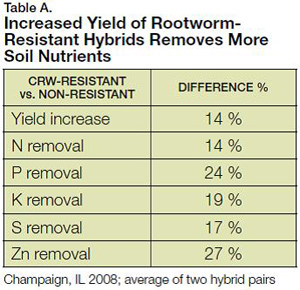The Mosaic Company
Seed industry leaders Dow AgroSciences, Monsanto, Pioneer Hi-Bred and Syngenta have all set aggressive goals to increase corn yields. Doubling yields by 2030 is an admirable and daunting goal that plant breeding and biotechnology are sure to play a huge role in achieving. However, in addition to these new technologies, new management practices will be required to optimize yields.
In 2010, 47 percent of U.S. corn acres were planted to stacked-trait, insect-resistant hybrids, but little is known about the effect of technology on corn nutrient uptake and the exact nutrition needed to optimize yields. That’s why researchers at the University of Illinois, Urbana-Champaign, are comparing the nutritional needs of these hybrids to their non-resistant counterparts. Preliminary research results show the nutrient uptake of resistant hybrids is significantly greater than their non-resistant counterparts.
Intact roots absorb nutrients more efficiently
“CRW-resistant hybrids change everything,” says Dr. Fred Below, professor of Plant Physiology, University of Illinois. “Because rootworm larval feeding is suppressed, and therefore the root system protected from damage, the corn plant absorbs nutrients more efficiently and ultimately realizes a higher yield potential.”

More efficient nutrient uptake suggests higher levels of nutrients are needed to achieve that added yield potential. In the University of Illinois trials, CRW-resistant hybrids yielded 205 bushels per acre, while the non-resistant hybrids yielded 179 bushels per acres, a 14 percent difference.
“Results of our initial trials show that the per-acre removal rates of nutrients [nitrogen (N), phosphorus (p), potassium (K), sulfur (S), zinc (Zn)] are from 14 to 27 percent greater for hybrids with the rootworm-resistant gene,” adds Below. “In fact, both the yield and the concentration of nutrients in the grain were higher for the transgenic hybrids.”
“As we look at these results, we see very large increases of Zn and P removal, in particular, which means soil test levels of these nutrients may rapidly decrease,” Below points out. “As corn rootworm-resistant hybrids become increasingly popular and are planted every year, it will be important to take these trends into account as nutrient management plans and fertilizer recommendations are formulated.”
With nearly half of U.S. corn acres planted to transgenic hybrids costing as much as $100 to $140 per acre for seed, it’s important growers apply the nutrition needed to optimize yields and generate a good return on these genetics.